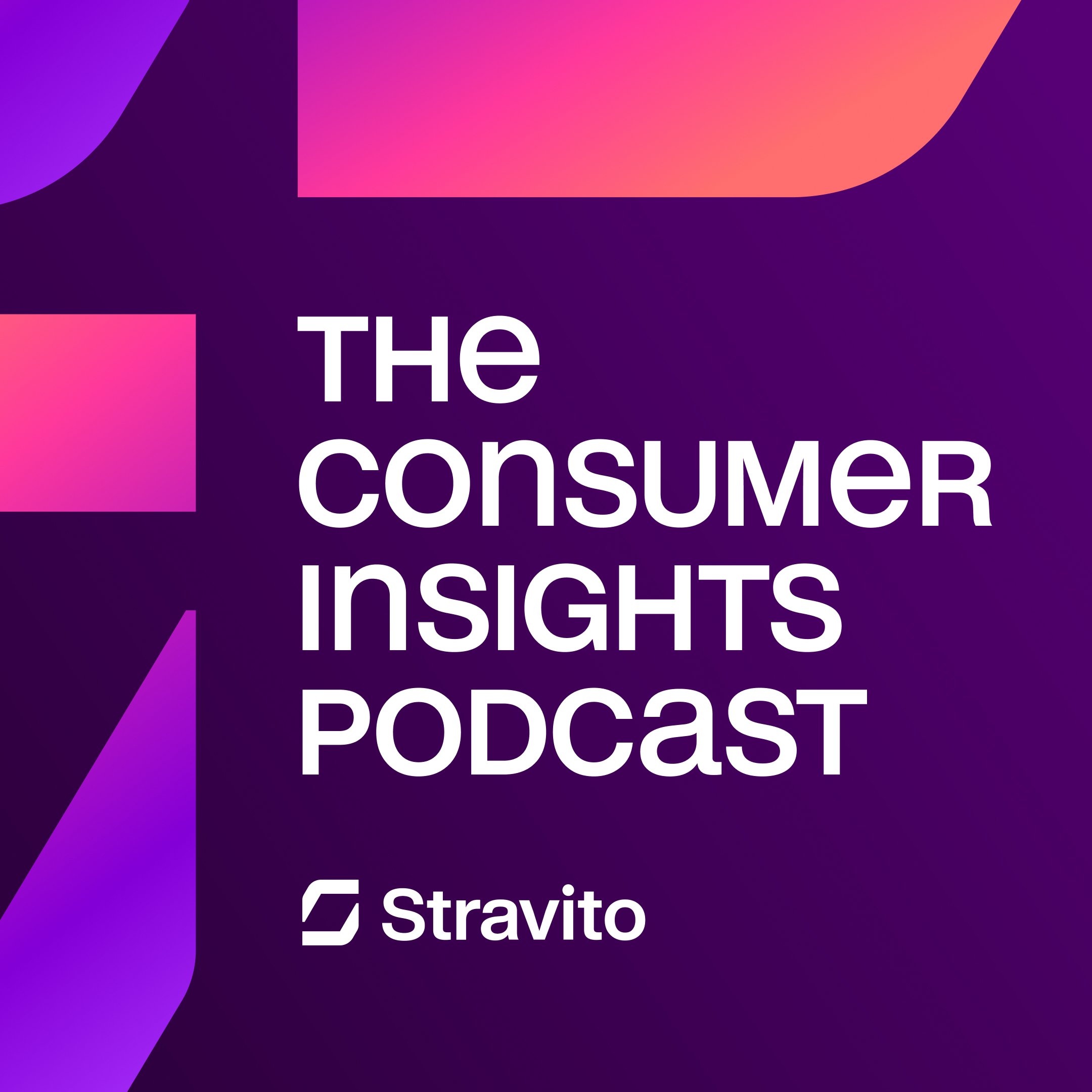Creating a Consumer-Centric Culture
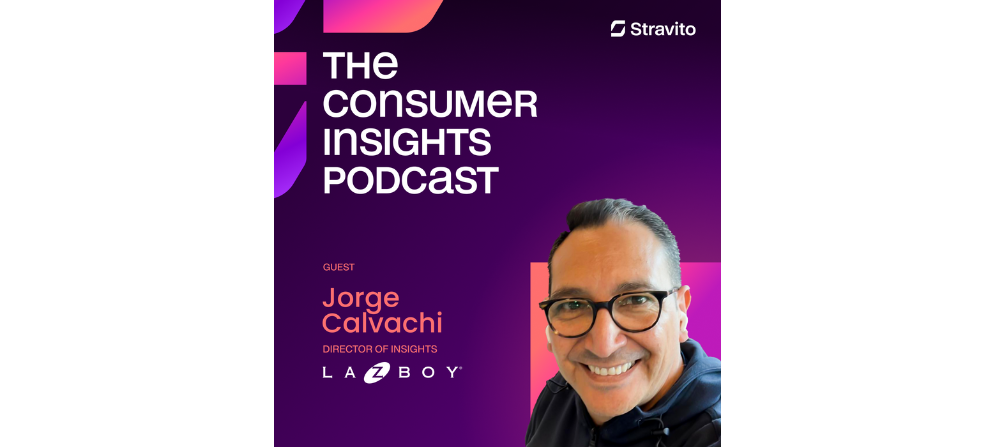
In this episode of the Consumer Insights Podcast, we speak with Jorge Calvachi, Director of Insights at La-Z-Boy.
Knowledge is power – that’s never changed. But the way to use that power has.
Gone are the days where insights should be locked in a vault. Today, it’s essential to democratize insights for stronger relationships with your stakeholders and consumers.
In this episode of the Consumer Insights Podcast, Thor is joined by Jorge Calvachi, Director of Insights at La-Z-Boy Incorporated, who shares how insights leaders today can create more consumer-centric cultures.
They cover:
-
What has (and hasn’t) changed with insights in the last 25 years
-
How the right insight can turn a struggling product into a game changer
-
The role of insights leaders today
-
Why connecting with consumers is essential
-
How repositioning sustainable products can lead to major success
-
How insights can contribute to building a better world
-
How technology has changed insights work and what that means for businesses
-
The importance of connecting people with data
-
Key skills for successful insights leaders
-
The challenges currently facing insights leaders
If you’re interested in exploring what it takes to create a consumer-centric culture, tune into this episode of The Consumer Insights Podcast.
You can access all episodes of the Consumer Insights Podcast on Apple, Spotify, Google, or use the RSS feed with your favorite player. Below, you'll find a lightly edited transcript of this episode.
Thor Olof Philogène: Hello everyone, and welcome to the Consumer Insights podcast. Today I'm excited to have an amazing Insights leader joining me for what I know will be a fantastic conversation. I'm thrilled to introduce today's guest, Jorge Calvachi, director of Insights at La-Z-Boy, a truly iconic brand and one of the world's leading residential furniture producers.
Jorge has over 25 years of Insights experience, having previously worked at companies like Kraft Foods, General Mills, Clorox and Amway. And he has an MBA from the University of Illinois, Urbana Champaign. Thank you so much for joining me Jorge.
Jorge Calvachi: Well, thank you for inviting me. When you say 25 years of experience, it just took me back to memory lane.
Thor: Well, let's talk about memory lane. Why don't you take a couple of minutes, tell us about yourselves. How did that journey begin?
Jorge: Good segue. So, first I didn't know that consumer insights existed. It just happened that I was at the University of Illinois and I met some people from Kraft Foods and they started talking about consumer insights and marketing. And I thought that was fantastic. So I gave it a try. And yes, you're right, that was 25 years ago.
I started my career at Kraft foods. What is very interesting is that within two years, I started doing something completely different that nobody else has done, not only in the company, but only a few in the insights industry. Which was to establish a multicultural department.
This is when the census came out and there were about 45, 47 million ethnic consumers. Nobody was really targeting them, with the exception of a few companies. So that was very interesting. I had to learn so much, breaking new ground.
And then I moved to another position, which was very interesting at General Mills. I was in charge of Consumer Insights, in innovation, in cereal. I love innovation. I think that that is where you get creativity, you get analytics and they overlap and you come up with great ideas.
That was a fantastic opportunity. After that, I moved to Clorox. Clorox was expanding aggressively internationally. It was a great role. I always wanted to do global insights and that gave me the opportunity to travel everywhere and understand consumers from many different markets.
And after that, I got a call from Amway. Amway, a very large company, particularly in Asia. I will say that Amway is a true global company because 92% of the revenue comes from overseas. And if I compare it to like Kraft Foods, Clorox, their international revenue is about 20 to 25. Maybe a little bit more, maybe that has changed.
But when you are talking about a company that is based in Michigan, and 45% of the revenue comes from China, and we're talking about billions and billions of dollars. Right. It was quite amazing.
And now I am at La-Z-Boy. During the pandemic, it was a time to reflect. I needed to do something different. So again, I got this call from La-Z-Boy. I decided to open myself to new opportunities. And in La-Z-Boy, this, as you mentioned, iconic brand, 95 years in the industry. They never, ever had an insights department.
And they are successful, and they're doing quite well. But because of the pandemic and new leadership, they decided that this is the right time for insights. And here I am.
How Jorge defines insight
Thor: That's a fascinating story, Jorge. And I think with those 25 years, I'm sure your definition of an insight has changed over time. So how do you define it? How do you define an insight?
Jorge: I find it interesting that you say that definition of an insight has changed because a definition of a vision hasn't changed. A definition of a strategy doesn't change. It is what it is.
But what changes in the marketplace is the way you go to market, the way you relate to consumers. Consumers attitudes, consumer preferences and behaviors do change
Insights, a true definition of an insight, doesn't change. So let me explain a little bit more what that means. I was really lucky that within my first two, three years, I experienced what an insight was. So instead of giving you a definition of what an insight is and what an insight is not, let me tell you a story.
Thor: I love stories.
Jorge: Yeah, and then we can unpack what the story brings and what that definition is.
All right, so let me take you to Kraft foods.
I am working in Kraft macaroni and cheese. The company, one of the main initiatives is convenience. So what everyone did is took every single product and brand and tried to make it more convenient.
So here I am, with the team, and we're talking to consumers on how to make this Kraft macaroni and cheese more convenient.
Consumers are saying, “Okay, I open the box, I boil some water, put the pasta, and then I put the cheese. That is about six minutes.” It is already convenient, right?
So then we say, “Okay, well, R&D came out with this microwaveable mac and cheese.” We went back, we talked to the consumer, and whenever we mentioned “microwaveable mac and cheese”, nobody wanted it. This product almost died like four or five times.
Our product was preferred on a blind test, but we just can’t communicate to the consumer.
And we had one more try to figure out how we can position this product, how we can make it a success.
And what happened is that we knew that we had a good product, but as soon as you say “microwaveable”, the perception that it was going to be bad was too strong to overcome.
But when we did blind testing of this product– we would have our microwaveable product and the regular mac and cheese. Our product was preferred on a blind test, but we just can’t communicate to the consumer.
And we had one more try to figure out how we can position this product, how we can make it a success. So here we are, focus groups. We had all the data, we did all of that and here we are with focus groups. And I remember bringing mac and cheese, this microwaveable mac and cheese and showing people how it is done. There were about seven or eight moms there, and then one mom said interesting, “Now if I get this, my kid can make it himself.”
And at that moment, we got goosebumps because that is the moment that we realized, “That's it! We have been talking about this product in the wrong way. This is about the ability for kids to make their own warm snack after they come home from school.”
And most importantly, when you are six or seven years old, making your own warm snack creates confidence. So we talked about this as a confidence booster for kids.
And yes, convenience took a secondary role. We didn't even talk about it because it went from six minutes to 0 seconds though, in terms of engagement with mom. This product you may have tried, it is called Kraft Easy Mac, and it basically changed the structure of the market when it comes to market mac and cheese. Huge success.
Why insights are so important
Thor: I love the story, Jorge, and I also think that you are talking about it from, of course, not giving me the definition, but rather the example. And I love that.
But tell me from your perspective now that you've made it clear for that story, why is it that these insights are so important? And again, taking it to your journey at La-Z-Boy, coming in there with no insights, functioning, existing, why is it so important to put that in place?
Jorge: You know, what I love is that I think that almost everyone has access to the same information and knowledge, and sometimes we don't pay attention to specific behavior or attitude or perception.
And it is the job of an insights leader. Basically see the same information that everybody has done, has seen it, but somehow connect it to the consumer. In this case, the Kraft Easy Mac, it was hitting us in the face all the time.
I mean, we had the right product; we just didn't know how to connect with the consumer. Once we connected, it just took off completely. But we need to see it in a different perspective of how this product was going to benefit the consumer.
And in this case, we completely even changed the message. It wasn't even about the mom and convenience. It was about the kids and building their self confidence, making all the difference.
I mean, we had the right product; we just didn't know how to connect with the consumer. Once we connected, it just took off completely. But we need to see it in a different perspective of how this product was going to benefit the consumer.
So now unpacking this a little bit more. Now, I give you the information about qualitative focus groups, but there was a lot of data behind all of that. Then we figure out what is the percentage of kids within this segment, what are the attitudes of a mom that they want their kids to be more self confident, to grow and try new things, the percentage of kids that are like kids.
So all of that once you start putting all this together, it was in front of us. We just didn't connect the dots correctly and position it in the right way.
Jorge's favorite brand to launch
Thor: 100%. I'm with you. I think that's such a solid way of thinking about it. Now tell me, Jorge, throughout your career you've launched over 40 brands. Do you have anyone that was your favorite to work on? If so, why?
Jorge: Interesting. Well, it has been an interesting ride but in terms of launching new brands and this has been let me see I'm thinking about an example here. I will say Green Works.
Green Works is a product that we introduced at Clorox. This is the time that everybody is talking about sustainability and the environment. Of course, today we are all talking about it too. But at that moment, at that time we were in a way kind of like not pioneers, but we figured out how to do it a little bit better than others.
Number one, consumers. If you want to appeal to a broader set of consumers, you have to focus on the performance of the product more than anything else. The product still has to work, and then yes, it is good for the environment.
What I'm trying to say here is that, for instance, when you talk to people, “Are you eating healthy?” People say, “Yes. Of course I am.” And then we will go and see in their pantry, and then there's all this product that is all prepackaged. When we ask people, “Are you recycling?” “Of course I am.” But they are not.
The products that are usually in the marketplace are trying to make people feel guilty about not doing the right thing. So we took a different angle.
The products that are usually in the marketplace are trying to make people feel guilty about not doing the right thing. So we took a different angle. We basically positioned this as a product that, number one, it works. That is why it was called, Green Works.
We also figured out how much more consumers are willing to spend for a green product, and that was only about 20% to 25% more. And then we position it as you can do a little bit, just a little bit. Not everything that you do and buy has to be green, but in this case, this small purchase can help the environment.
Of course, we didn't talk about this, but it's only 20% more, and it works. When we launched the product, I really liked it because we had to update the forecast five times within a year because we couldn't produce enough. Just because we said “Hey, we know it is hard, but here's just a little bit that you can do for the environment.”
The role of insights in building a better world
Thor: That's a very nice situation to be in Jorge. Now on LinkedIn, you describe yourself as “a world humanologist who focuses on the future of humans and society to envision a better world.” How would you describe the role of insights in building a better world?
Jorge: Whenever you have connections with people all over the world, it's just incredible. I have done research in more than 70 countries, and I would say 20 or 30, doing deep insights, spending time in people's homes.
And I remember when I wrote that, that was maybe 10, 15 years ago. Because we always feel that people from other countries, other religions, are different from us. But at the core, we are so similar.
Because we always feel that people from other countries, other religions, are different from us. But at the core, we are so similar.
We all want the same things that everyone wants. We want to be good human beings. We want to raise kids to become positive members of society. We want education for our kids. We want to believe in something.
And for me, that is very, very important. And if I can do just something to help with that, with what I do, insights, helping people understand how to make better decisions, better informed decisions, yeah, that's great.
Essential tools for insights professionals
Thor: I think that's exactly the right way to think about it. Now, you've also come across a great variety of tools in your career. What tools would you highlight as the ones that are essential to support insights professionals? And why?
Jorge: Now that has changed during my life in Insights. And it makes sense because at the beginning I was focusing more on what we do, right? What type of methodologies?
Technology has impacted us quite a bit. Technology, you know, how we do it. With artificial intelligence, machine learning, all of that stuff is just wonderful – how this has impacted and shaken the insights industry. And we needed to be shaken. There are many reasons for that. I mean, right now, we are one of the most important departments and functions in any company, not only at La-Z-Boy, but the way that it has changed for me now that I have 25 years to reflect is: why do we do this?
I love creating a culture that is consumer-centric. So the tools that help me create that environment where people can access data 24/7, anywhere in the world, identify it in such a way that is easier to digest - some people call it democratizing, socializing data. That is important to me.
Why do we do insights? You know, it's not about the reports. It's not really about finding something meaningful to grow the business. I mean, it is. But at the core, for me, is that I love creating a culture that is consumer-centric. So the tools that help me create that environment where people can access data 24/7, anywhere in the world, identify it in such a way that is easier to digest - some people call it democratizing, socializing data. That is important to me.
I know that this is a little bit of a shoutout for you guys, but Stravito is important to me because of that goal of creating a consumer-centric organization. If you cannot give people data and knowledge and insights, you're going nowhere.
There was a point in my career where I remember people telling me, “Jorge, knowledge is power. You keep it in the vault.” And that has been a 180 degree turn. That has to be transparent. Everything that we do in insights, not only has to be transparent, but it has to be socialized as much as you can.
Unlocking the potential of teams and organizations
Thor: Jorge, I love what you're saying, and I also know that you're passionate about unlocking the potential of teams, organizations. Do you have any practical tips or advice you can share with us about how you do that as an Insights leader?
Jorge: From an insights leadership perspective, we are so focused on connecting data. And there is nothing wrong with connecting secondary data, trends, primary data, qualitative, transactional data. Nothing wrong with it. Perfect, right? I have been doing that all my life.
It is only in the last few years that I realized that what is more important is connecting people with the data. People that have similar questions, similar challenges. So when you connect people with the data, they have something to talk about, and that is where the good conversations happen.
My job is to make people and teams thirsty and then just put the data out there for them to access it themselves.
So my goal is those relationships, understanding what the challenges are to unlock growth. I have implemented something that is an organizational learning plan. So I am in marketing. My work is the entire organization – so talking to R&D, talking to innovation, talking to merchandising, sales, you name it, and understanding what they need to know to unlock growth. Once I have those forms filled out because of the conversations, I can connect insights, and I can connect people that have the same challenges.
I like to say that I like to make them thirsty. One time I was very frustrated because we did this awesome research, and it didn't go anywhere. Afterwards, my boss said, “You know, Jorge, you can lead a horse to the river, but you cannot make them drink water.”
And I thought that that was interesting, that was great. It made me feel good at that time, but I feel now that my job was not even trying to make the horse drink water, or even leading the horse to the river. My job is to make people and teams thirsty and then just put the data out there for them to access it themselves.
How to create a thirst for insights
Thor: I absolutely love this analogy. Jorge, I think, is so spot on. And if you take a look at the insights team and how those teams interact with the broader organizations, what skills do you believe are essential to create that thirst, to make them thirsty?
Jorge: One of the awesome things about La-Z-Boy is that my values, especially insights values, are so connected to the overall values of La-Z-Boy.
And number one is curiosity. And if you think about insights, it's all about curiosity, trying to get to the truth. But most importantly for me, I like proactive curiosity.
It is with those relationships, when you know how people make decisions and what they need to know that then you keep this and you always keep an eye on this. And whenever you get data, secondary or primary, or even an article in a magazine, you always keep that communication with those team members, business leaders.
And that is why I say, proactive curiosity. So you're always on top, make yourself unforgettable, always be on top of things, right? And that is what I love about La-Z-Boy with curiosity.
We know that attitudes have changed, right? Because of the pandemic and new generations coming with different behaviors, perceptions. We always have to be on top of everything, optimizing. So courage to ask the tough questions and to put a stake on the ground.
The other one is courage. So for me, courage is particularly important in insights. Number one, we are the ones that need to be asking the tough questions. When we hear, “We're investing here, so many dollars in media,” or “This is the way we go to market, and our training works,” we should be asking, “How do you know? Is there a better way to do this?”
We know that attitudes have changed, right? Because of the pandemic and new generations coming with different behaviors, perceptions. We always have to be on top of everything, optimizing. So courage to ask the tough questions and to put a stake on the ground.
I remember when I started my career, I would say “We should do this.” And I remember my boss saying, “What about let's change that to, ‘Let's explore considering something else.”
Compassion, it's a little bit higher than empathy because with empathy you actually say, “Well, I'm sorry that this happened to you. I can see that that could be bad or terrible,” but it stops there.
Now, I mean, that has to change, and it has changed, but that is the courage to do that.
And the other one for me is compassion. Compassion, it's a little bit higher than empathy because with empathy you actually say, “Well, I'm sorry that this happened to you. I can see that that could be bad or terrible,” but it stops there.
That is when you deliver a report, you're creating empathy. You create compassion when you actually take those insights with a team and then you say, “Okay, we all feel empathy for the consumer, right? So compassion is what are we going to do to resolve, to remove that pain point, to create a better consumer experience?”That is compassion. It's proactive, it is action-driven, and there is a goal.
Challenges on the horizon for insights professionals
Thor: I think you're putting your finger on something super important because we've talked about empathy a great deal actually on this podcast. And I think that there is another level which is compassion, which actually puts you even closer to whoever you are talking about. I absolutely love that.
Now, when you take a look at the industry and everything that's going on, what's the biggest challenge that you see? What is it that you spot on the horizon?
Jorge: Good question. I will say that for the insights industry, the ability to be more agile. And it is not only about conducting research in an agile way.
And agile doesn't mean do it faster, it means to have the flexibility to react. It's the adaptability to change your research.
I believe that this is the time where there is so much complexity, ambiguity and volatility in this market, among consumers and among companies, that our role has become critical.
So if you are not playing that leadership role to minimize risk and guide the company in decision making, you're missing out.
But I believe that the challenge for insights leaders is to take the leadership of the department to a different level and not to play a secondary role. I believe that this is the time where there is so much complexity, ambiguity and volatility in this market, among consumers and among companies, that our role has become critical.
So if you are not playing that leadership role to minimize risk and guide the company in decision making, you're missing out.
I like to say also that for the last 20 years we have been asking to be at the table. Right now, you must be at the table. If you are not at the table, you are on the menu, and that is not a good place to be right now.
So I think that that is important. I think that leadership needs to step up. I think that we have to use technology, as much as we can, to experiment. And I will say that the days where R&D, supply chain used to create competitive advantages, I believe that consumer centricity is what is going to create a competitive advantage.
Who in the world of insights Jorge would love to have lunch with
Thor: Thank you so much for that, Jorge. I think you really highlighted a lot of key themes for us to keep in mind.
It hurts me that we've come towards the end of our conversation today and as you know, there's one question that I love to ask which is: who in the world of insights would you love to have lunch with?
Jorge: I would say let's have it as dinner instead of lunch because I feel better ordering a bottle of wine with dinner than with lunch.
And I'm going to expand. Maybe some people will consider it the world of insights. For me, insights is basically applicable to a lot of spaces.
So I will say Malcolm Gladwell. He is not in the insights industry, but he is in insights. Let me tell you why.
I love the way he looks at a situation that everyone has looked at, but he has a different angle to analyze it and to see it that we never thought about it.
So I love reading his books. By the way, I have met him, very interesting. I didn't have dinner with him, but I would love to actually spend a couple of hours, a bottle of wine, and just try to understand how he sees the world, how we make decisions. That would be very interesting.
Summary
Thor: That would be a very interesting dinner. Read many of his books and I agree with you, he definitely has that ability to think about things in a very different way.
Wow, Jorge, this has been such an incredible conversation. I've really enjoyed hearing your unique perspective on insights, leadership, and particularly how you've used insights to envision a better world.
If I play back some of the things I will bring with me from this conversation, you reminded us that when you were telling us about an insight and how to define it, you actually gave us the example from your time at Kraft working with their mac and cheese.
And it wasn't about the qualities of the product, but it was what those qualities enabled the customers to do. You reminded us that at the core is a love for creating a culture that is consumer-centric. And in order to make that possible, democratizing insights is crucial.
And lastly, you've told us that many people will tell you that you can bring the horse to water, but you can't make it drink. But you told us that our job as insights leaders is to make them thirsty.
I know that I've learned a lot from talking to you today, and I'm sure our audience has as well. Thank you so much for joining me.
Jorge: My pleasure. Have a good one.
Related Content
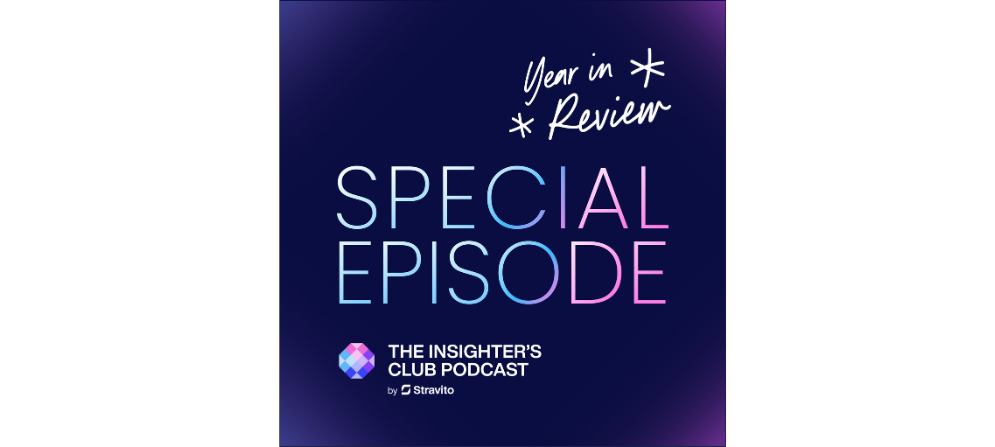
2025 Year In Review
In this special end-of-year episode of the Insighter's Club Podcast, Ross is joined by Stravito Founder & CEO Thor Olof Philogène.
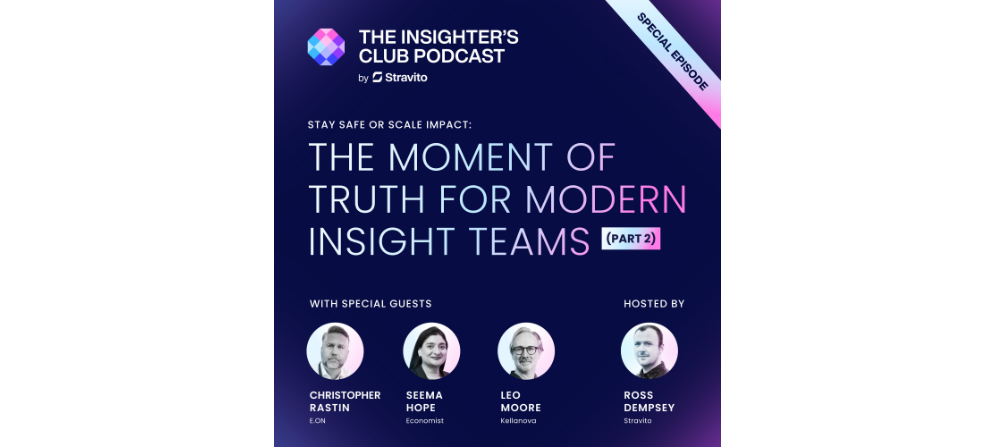
Stay Safe or Scale Impact: The Moment of Truth for Modern Insights Teams (Part 2)
In this special episode of the Insighter's Club Podcast recorded live at the Stravito Customer Summit in Paris, Ross is joined by Seema Hope (VP of...
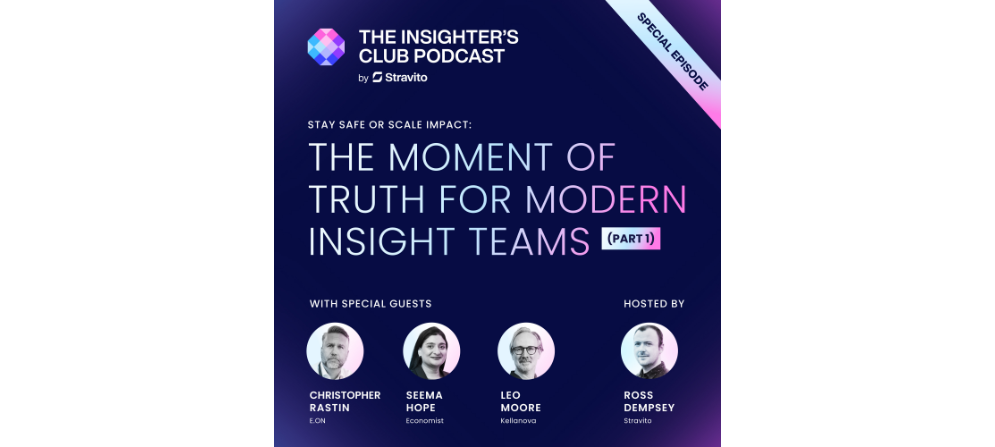
Stay Safe or Scale Impact: The Moment of Truth for Modern Insights Teams
In this special episode of the Insighter's Club Podcast recorded live at the Stravito Customer Summit in Paris, Ross is joined by Seema Hope (VP of...
Subscribe to the latest podcast updates
